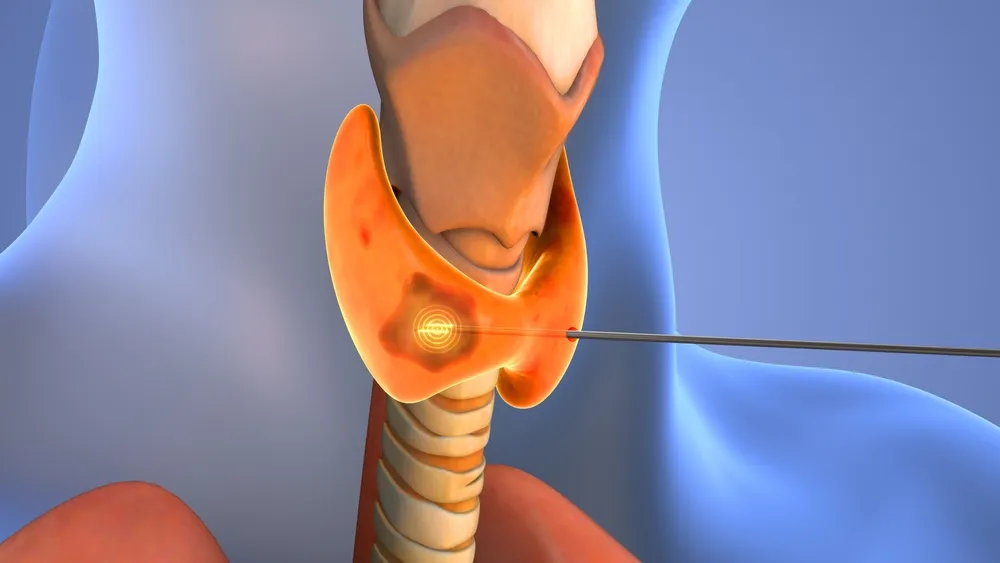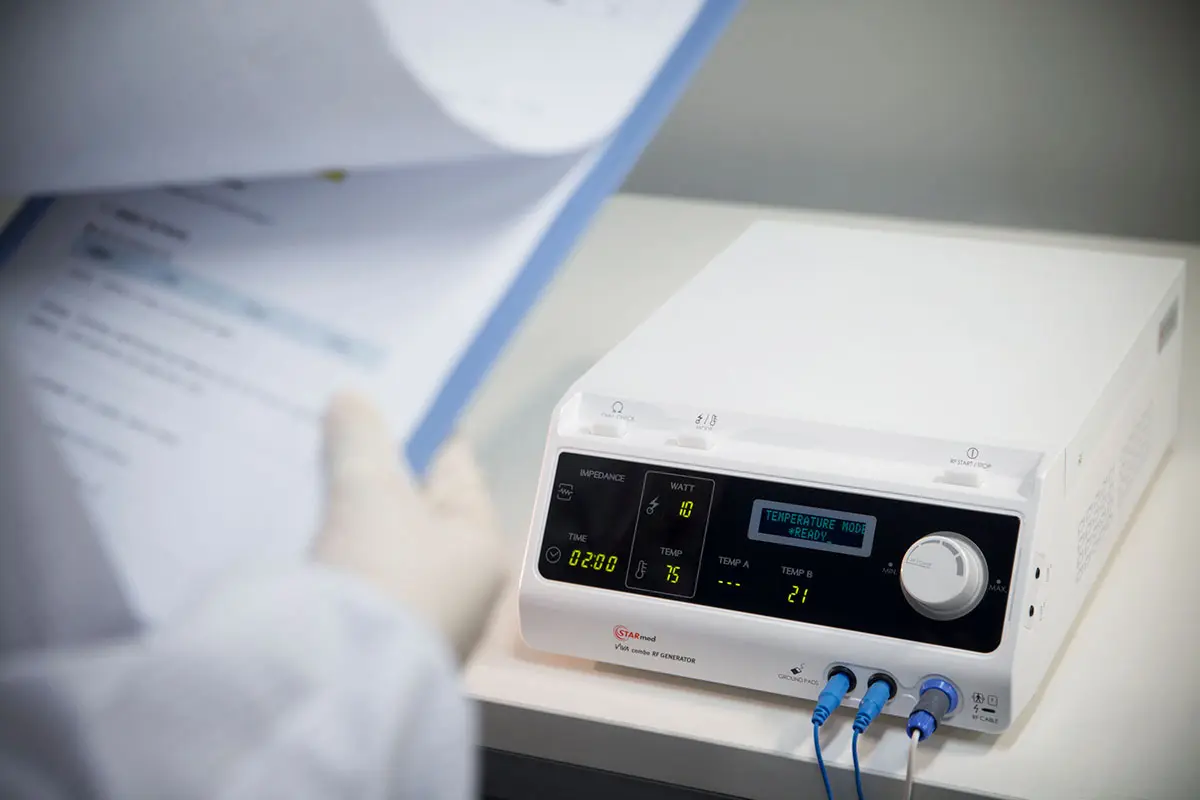TL;DR: Thyroid nodules are common and usually benign, but every nodule deserves structured evaluation to decide if and how to treat. This guide explains what causes thyroid nodules, what causes them to grow, and how to build an evidence-based plan that prioritizes minimally invasive options like RFA.
- Common causes: benign tissue overgrowth, Hashimoto’s thyroiditis, iodine imbalance, prior head/neck radiation, and demographic risks (female sex, age, metabolic syndrome).
- Growth cues: most benign nodules enlarge slowly; rapid growth or compressive symptoms warrant urgent ultrasound and possible biopsy.
- First-line workup: thyroid function tests, high-resolution ultrasound, and FNA when sonographic features or size thresholds indicate.
- Treatment menu: observation, limited use of TSH suppression, RAI for toxic nodules, PEI for cystic nodules, thermal ablation (esp. RFA), and surgery when cancer is suspected.
- Why RFA: outpatient, no scar, preserves thyroid function, low complication and hypothyroidism risk, with substantial long-term volume reduction.
- Thyroid nodules occur four times more often in women than in men
- By age 60, up to half of people may have at least one thyroid nodule
- Components of metabolic syndrome (obesity, insulin resistance) may play a role in nodule formation
- A hard, fixed nodule
- Associated hoarseness or lymph node enlargement
- A history of childhood neck irradiation
- Rapid growth of the nodule
- Active Surveillance: Periodic ultrasound and clinical follow-up without immediate intervention for benign, asymptomatic nodules.
- Thyroid Hormone Suppression Therapy: Low-dose levothyroxine to mildly suppress TSH in an attempt to limit nodule growth.
- Radioactive Iodine (RAI): Oral I-131 that’s preferentially taken up by overactive thyroid tissue. The goal is to reduce hormone production and shrink toxic nodules.
- Ethanol Ablation (PEI): Ultrasound-guided aspiration and injection of ethanol into predominantly cystic nodules to sclerose the lining and collapse the cavity.
- Thermal Ablation (Radiofrequency or Laser): Minimally invasive, ultrasound-guided heat ablation of benign solid nodules to achieve substantial volume reduction while preserving thyroid function.
- Surgery (Thyroidectomy or Lobectomy): Operative removal of part or all of the thyroid. It’s most typically selected for malignancy, strong suspicion of cancer, or large symptomatic nodules.
A thyroid nodule most commonly represents a simple overgrowth of normal thyroid tissue. We refer to such nodules as colloid nodules or thyroid adenomas. The vast majority of these benign nodules have no definitive underlying cause. Even so, all thyroid nodules warrant careful evaluation to determine if treatment is a wise next step.
In this guide, we’ll discuss what causes thyroid nodules generally, as well as what causes thyroid nodules to grow. Finally, we’ll share our expertise about how clinicians can formulate effective thyroid nodule treatment plans.
Continue reading to learn how to counsel patients as they navigate a new thyroid diagnosis.
What Causes Thyroid Nodules?
Thyroid nodules are extremely common in clinical practice. In fact, high-resolution ultrasound surveys have detected thyroid nodules in up to 68% of otherwise healthy adults. The good news is that up to 95% of such nodules are benign.
There are several known factors that can lead to the development of nodules on the thyroid, however. For example, chronic inflammation of the thyroid, as seen in Hashimoto’s thyroiditis, is one common cause.
Iodine deficiency is another well-established cause of thyroid nodules and goiter. This is less common in the United States due to access to iodized salt. Without enough iodine, the thyroid can be overstimulated by thyroid-stimulating hormone (TSH). That can result in the development of multinodular goiters over time.
Conversely, overexposure to iodine can sometimes have the same result.
Radiation exposure to the head and neck is another significant risk factor for thyroid nodules. This is especially common for those who experienced exposure during childhood. For example, adults who survived childhood cancers are more likely to experience nodules in adulthood. These nodules may or may not be cancerous.
We’ll discuss more about malignant thyroid pathology later in this article.
Demographic Predispositions that Cause Nodules on the Thyroid
What Causes Thyroid Nodules to Grow?
Growth behavior can vary widely from nodule to nodule.
Benign nodules typically do not grow rapidly. Such nodules may never cause symptoms. Others may gradually enlarge due to continued cell proliferation or fluid accumulation. A sudden or rapid increase in nodule size is unusual for benign nodules and should raise a red flag.
Any notably fast-growing thyroid nodule warrants prompt re-evaluation. Such nodules often demand repeat ultrasound and possibly a biopsy to rule out thyroid cancer.
Pregnancy and hormonal changes may also spur nodule enlargement in some cases. This is due to the thyroid’s increased activity and blood flow during gestation.
Malignant Thyroid Nodules
Thyroid cancer is the most serious cause of a thyroid nodule. Malignant nodules account for only about 5% or less of nodules. Each newly discovered nodule should be evaluated with cancer in mind.
Clinical features that raise concern for malignancy include:
Formulating an Effective Thyroid Nodule Treatment Plan

Formulating a treatment plan for a patient with thyroid nodules requires a balanced approach. It should take into account the nodule’s cause, characteristics, and the patient’s clinical situation.
The first priority is always to assess the risk of cancer. This is achieved via a combination of thyroid ultrasound imaging and, when indicated, a fine-needle aspiration (FNA) biopsy. If the nodule is confirmed benign, you can focus on managing the nodule’s effects.
Thyroid nodule treatment can be grouped into the following treatment options:
Among these options, Radiofrequency Ablation (RFA) has emerged as a game-changer in thyroid nodule treatment. It offers a nonsurgical outpatient solution for shrinking nodules that cause symptoms or cosmetic concerns. Clinical studies in the U.S. and abroad confirm that RFA is both effective and safe.
Moreover, RFA is done under local anesthesia, requires no hospital stay, and leaves no scar on the neck. The risk of hypothyroidism after RFA is very low because the majority of normal thyroid tissue is left intact. Patients typically return to normal activities within a day or two.
Current international consensus guidelines recommend RFA for patients with benign thyroid nodules that are causing symptoms or growing. It should be considered as a first-line alternative to surgery in experienced centers.
Treat the Causes of Thyroid Nodules with RFA
Thanks to advances like RFA, we now have the ability to treat thyroid nodules in a minimally invasive way. RFA helps many patients avoid invasive surgery while still achieving excellent nodule reduction and symptom relief. Clinicians should remain up-to-date on these evolving options. Ongoing education is the best way to ensure they are offering the most appropriate, evidence-based care.
Visit the STARmed America Thyroid RFA page for additional information on radiofrequency ablation technology and training resources.





